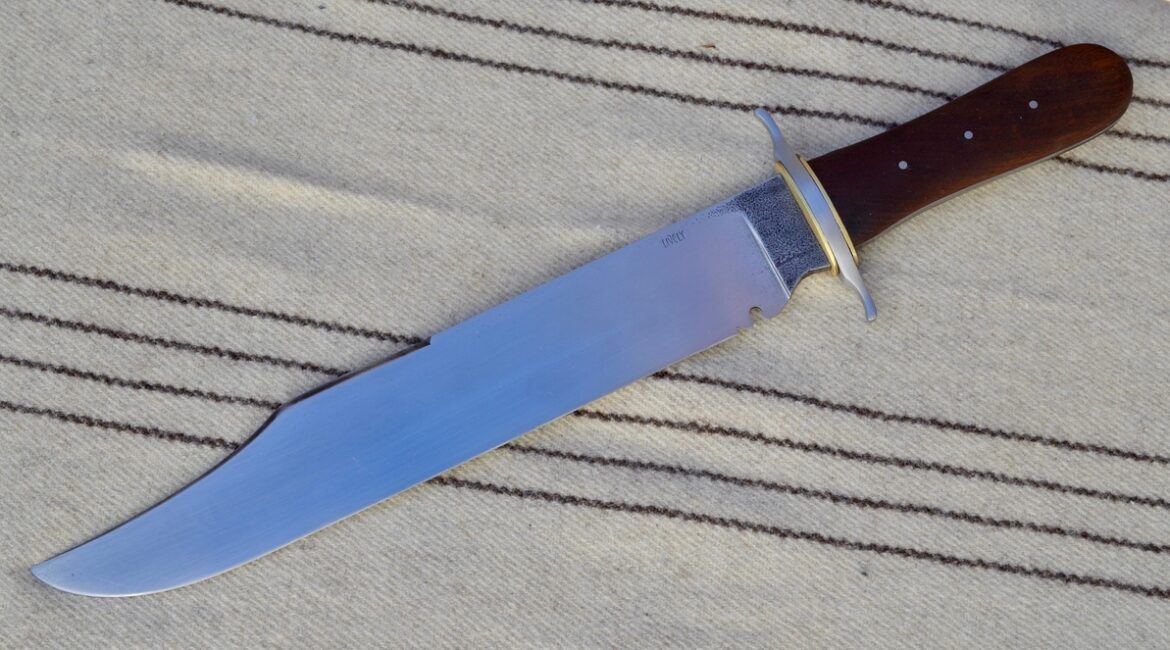The Bowie knife is more than just a cutting instrument; it is a symbol of the indomitable American spirit and an essential piece of the nation’s history. Owning a Bowie knife connects one with the country’s pioneering past and serves as a testament to the valor and resourcefulness that are hallmarks of the American ethos. It’s a must-have for anyone who values America’s rich heritage of adventure and bravery.
But where did it all start?
James Bowie remains an iconic figure in American history, remembered for his role in the Texas Revolution and for the large, distinctive knife that bears his name. The creation of the Bowie knife is a story rooted in survival, necessity, and personal defense. The story begins in 1826, when James Bowie and his brother Rezin were involved in a contentious business landscape in Louisiana. After a failed business deal, due to a loan refusal from banker Norris Wright, tension escalated between the two men, leading to a physical confrontation. This conflict, while not fully documented, is central to the Bowie knife’s history. Following the altercation with Wright, Rezin Bowie presented James with a robust, custom-made knife, crafted by the blacksmith Jesse Clifft. It was meant for James’ personal protection, anticipating future encounters where a reliable weapon might be needed.
In the early 19th century, firearms, particularly flintlock pistols, were often unreliable. The Bowie knife, with its large blade, provided a dependable alternative for close-quarters combat, making it a preferred choice over the unpredictable pistols of the time. The Bowie knife’s reputation was cemented on September 19, 1827, during what is known as the Sandbar Fight. Following a duel between Samuel L. Wells III and Dr. Thomas H. Maddox, a melee erupted among the parties involved. James Bowie, amidst the fray, reportedly used his unique knife with lethal efficiency, although accounts of the event vary.
Despite the conflicting reports about the Sandbar Fight, the general consensus was that Bowie’s use of his knife during the conflict was notable. This incident catapulted the Bowie knife into the public eye, making it a sought-after weapon across the United States.
The Bowie knife enjoyed widespread popularity until the advent of more reliable handguns. As the Colt pistol and similar firearms became accessible, the need for large fighting knives like the Bowie declined.
The Bowie knife underwent significant transformations from its humble origins to become an American icon.
Initially fashioned after common butcher knives and Spanish hunting blades, the Bowie knife’s design evolved through the influence of various cultures and necessities. Its earliest form, characterized by a straight back and devoid of a handguard, served as a practical tool and weapon. Post the Sandbar Fight, the knife gained notoriety, prompting requests for more ornate versions. These custom designs incorporated elements like Mediterranean lines reminiscent of the traditional Spanish navaja, reflecting a fusion of influences that contributed to the knife’s unique appearance.
The integration of Spanish design elements into early Bowie knives points to a fascinating cultural exchange in the frontier territories. Bernard Levine notes the Mediterranean influence, particularly from traditional Spanish navajas, in shaping the contours of the Bowie. This amalgamation of design elements symbolizes the melting pot of cultures in early 19th-century America and illustrates the diverse influences that converge in the crafting of a legendary blade.
Originally conceived as a wearable short sword, the Bowie knife’s design was meant to offer a practical balance between the heft of a cleaver and the tactics of sword fighting. The blade’s increasing metal weight towards the hilt and its characteristic curved point were engineered for both slashing power and thrusting capability. This focus on utility epitomizes the American ethos of functionality and reflects the inventive spirit prevalent in the era of its conception.
The Bowie knife was not a one-size-fits-all tool; it was adapted into a variety of sizes and features to suit individual needs.
Later iterations boasted blades from 8 to over 12 inches, with innovations like the brass back inlay for added durability and shock absorption. The forward-bending upper guard, or S-guard, illustrates the knife’s evolution into a weapon designed not just for offense, but for defense, showcasing the thoughtful craftsmanship that went into each adaptation.
Today, the Bowie knife is an emblem of rugged survivalism and self-defense, its name forever linked to the adventurer and fighter James Bowie. While its origins may be mired in murky historical accounts, the Bowie knife’s impact on American culture and weaponry is undeniable.
The World’s Most Famous Bowie knife
Jim Bowie, handed over a wooden prototype of his ideal blade to the Arkansas blacksmith James Black in the waning days of 1830. In response, Black forged not only the knife that Bowie envisioned but also an enhanced variant with a distinctive feature: a honed edge along the blade’s curved top. When presented with both, Bowie selected the modified version, which ultimately became renowned as the archetypal Bowie knife.
The unique design, with its pronounced false edge, gained such prominence that it spurred mass production in Sheffield, England, under the moniker “Sheffield Bowie” knives. These exports, coveted in the United States, commonly bore handles of hardwood, deer antler, or bone, and were often adorned with silver fittings and guards. The James Black Bowie knife, with its substantial twelve-inch blade, epitomized the robust and imposing nature that Bowie knives had come to symbolize.
Bowie’s return to Texas bearing the James Black Bowie knife was marked by a dramatic confrontation in which he was ambushed by three gunmen intent on taking his life. The accounts from that era describe how Bowie, with his knife, lethally dispatched his assailants in a display of ferocity and skill that only heightened the knife’s legend. The Bowie knife, through such tales, transcended its role as a mere tool, becoming a symbol of frontier grit.
Jim Bowie’s demise at the Alamo solidified his and his knife’s mythic status. The whereabouts of the original knife crafted by Black have faded into the mists of history. Yet, a knife inscribed “Bowie No. 1” surfaced in a Texas collection and was subsequently acquired by the Historic Arkansas Museum, where it stands as a testament to Black’s craftsmanship, potentially authenticated through scientific methods, carrying forward the legacy of the iconic Bowie knife.
Bowie No. 1 Returns!
The famed Bowie Knife, known as “Bowie No. 1,” crafted by James Black for James Bowie in the 1830s, has made a significant homecoming. This knife, which helped shape the iconic status of the American Bowie knife, was acquired by the Historic Arkansas Museum from the collections of two Texas knife enthusiasts. Analysis by the museum’s curators confirmed the knife as a genuine creation of James Black, further enhancing its reputation as a prime example of an early American Bowie knife.
On January 17 2020, Bowie No. 1 was showcased to the public in Historic Washington for the first time since its acquisition, coinciding with the grand opening of the University of Arkansas Hope-Texarkana James Black School of Bladesmithing and Historic Trades. This event marked an important occasion, as the Arkansas Bowie knife holds the title of the official state knife. Bowie No. 1, recognized for its distinctive “guardless coffin” handle, is highly coveted among knife collectors and shares notable similarities with the Carrigan knife, suggesting that both originated from James Black’s workshop.
The grand opening, which took place at the new school’s location in the Janeens House, included a dedication ceremony for the “Arkansas #1” Bowie knife by Governor Asa Hutchinson. This knife was specially commissioned to honor the Bowie knife’s designation as Arkansas’s official blade and to celebrate Washington, Arkansas, as an official Arkansas Heritage Site.
The Evolution of Bowie Knife Manufacturing Techniques
The creation of the Bowie knife wasn’t just a step forward in personal defense; it was also a milestone in blacksmithing and manufacturing. Over time, techniques in crafting Bowie knives have evolved from the hands of artisan blacksmiths like James Black to modern manufacturing methods. Today’s Bowie knives are often made with advanced materials like high carbon steel and incorporate precision cutting techniques, ensuring durability and a sharp edge that can withstand rugged use. For enthusiasts looking to own a piece of this heritage, the Ka-Bar Becker BK9 Combat Bowie Fixed Blade Knife is a fine example of modern manufacturing meeting traditional design.
Bowie Knives in Modern Survival Kits
While the Bowie knife was originally designed for close combat, its functionality has expanded into the realm of outdoor survival. The large, sturdy blade makes it an ideal tool for a variety of tasks in the wilderness, from chopping wood to skinning game. Modern survivalists often include a Bowie knife in their gear, and the Schrade SCHF45 Leroy Full Tang Bowie Fixed Blade Knife is a popular choice for its robust construction and versatile design, making it a valuable addition to any survival kit.
Collecting Bowie Knives
Collecting Bowie knives has become a hobby for many history buffs and knife enthusiasts, with a special interest in those that reflect the characteristics of the originals from the 19th century. These collections often include both antique knives and contemporary replicas that honor the original design principles. For collectors looking to display or use these knives, purchasing a Cold Steel 39LSWB Marauder Knife captures the spirit of the traditional Bowie while offering modern-day quality and craftsmanship.
For serious collectors, the authentication of Bowie knives has developed into a fascinating sub-discipline. Understanding the provenance, the metallurgy, and the craftsmanship of the period can turn a collection into a historical archive. Advanced techniques, including spectral analysis and detailed metallurgical studies, are employed to authenticate the age and origin of these knives, distinguishing genuine antiques from later reproductions or fakes.
While many collectors focus on the early 19th-century models, others are drawn to the evolution of the Bowie knife’s design through the years. Collecting knives from different eras, including the Civil War period, the expansion West, and even into the 20th century, shows how the design was adapted for varying uses and reflects the changing tastes and technologies of knife-making.
Collecting custom-made Bowie knives is another rich vein. Contemporary bladesmiths often create Bowie knives that not only pay homage to the classic design but also incorporate modern materials and personal artistic flair. These knives are highly sought after for their unique blend of tradition and innovation, and some collectors commission custom pieces to create a more personal connection with their collection.
Another intriguing aspect of Bowie knife collecting is tracing its influence on pop culture. From cinematic depictions to literary mentions, the Bowie knife has a storied place in American folklore. Collectors may seek out memorabilia or editions of knives that are tied to specific cultural moments, films, or books where the Bowie knife played a role.
Serious collectors of Bowie knives also engage in learning about preservation and conservation techniques. Ensuring that antique knives are not only maintained but also properly stored and displayed is crucial. This can involve climate-controlled displays, learning about corrosion prevention, and even the restoration work by skilled craftsmen who specialize in historical weapons.
The Bowie Knife in Popular Culture and Media
The legend of Jim Bowie and his knife has been cemented in American popular culture, featuring in countless stories, films, and artworks. The image of the Bowie knife conveys rugged individualism and resourcefulness, attributes that are deeply rooted in the American frontier spirit. For movie buffs and cultural enthusiasts who celebrate this iconography, acquiring a Timber Rattler Western Outlaw Bowie Knife can bring a touch of that classic Americana into their collection.
Safety and Handling Education for Bowie Knife Owners
The ownership of a Bowie knife comes with a responsibility to understand and respect the blade’s power and potential danger. Proper education on handling and safety is essential for anyone owning or using a Bowie knife. Instructional books or a safety course can be invaluable, and knife owners can further protect themselves and others by using a SZCO Supplies Brass Guard Bowie Knife that features a hand guard, minimizing the risk of injury during handling.
The Bowie knife, in its many forms, has not just been a tool of survival and defense, but also a symbol of grit and resilience—a reflection of the spirit of the pioneers who carved a life in the untamed landscapes of early America.
- A Chat with Nate and Mika, Christian Wedding Photographers - July 18, 2024
- Ultimate Guide To Playing Online Casinos - May 27, 2024
- Addiction Recovery Books Worth Reading - January 24, 2024







